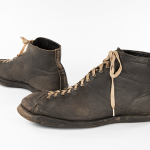Take a peek into our 14,000+ collection with our new blog series, From the Vault! Every week, we’re sharing interesting stories about one of our artefacts.
What is the provenance of this pair? When did they enter the BSM collection?
This pair of Amazigh (Berber) babouche came into the collection in 1994. They were acquired from a private collector.
Are there any features that distinguish this pair from other footwear from the same period and geographical location?
Many Amazigh shoes for women feature elaborate embellishment. This 1930s pair from the Ait Ouaouzguite in the Siroua Mountains of Morocco have green embroidery in the shape of large diamonds across the vamps, a design that references frogs which are symbols of fertility.
Can you elaborate more on the materials used to make this pair?
This pair was made using durable leather that has been dyed red. Red is considered a colour symbolic of life and Amazigh bridal shoes are often red. The majority of embroidery thread used to create the frog symbols is silk but metallic thread was also used in small areas. This form of footwear is called a babouche and is defined by having back quarters that are folded down transforming the shoe into a mule. Babouche come in a range of different styles and are popular across North Africa.
Who would have worn this pair and where or for what occasion?
Because of the use of red leather combined with the frog symbolism, it is possible that this pair was created to be worn for an important occasion. Weddings, for example, are important moments of transition and bridal footwear is often quite elaborate. However, there are many examples of Ait Ouaouzguite babouche with similar designs so exactly why this pair was made and who it was made for is currently unknown.


